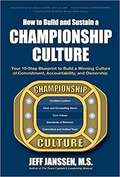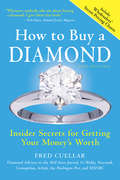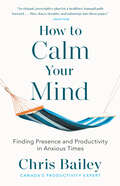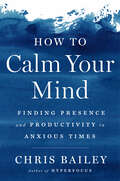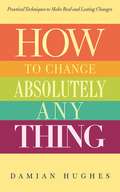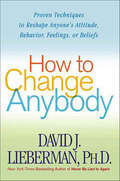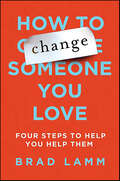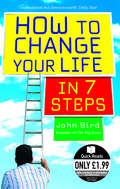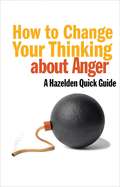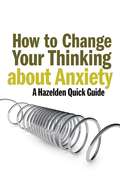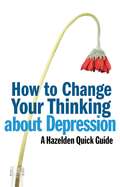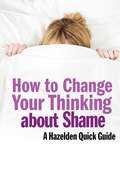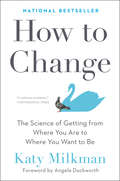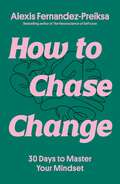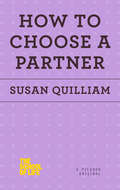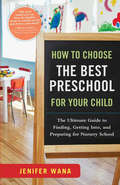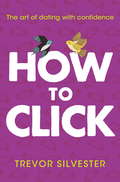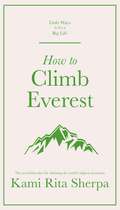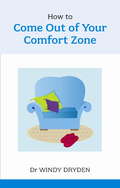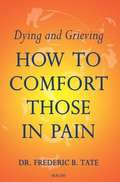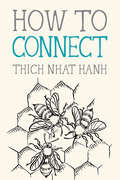- Table View
- List View
How to Build and Sustain a Championship Culture
by Jeff JanssenThis groundbreaking book reveals the 6 Key Components that all Championship Cultures have in common based on Jeff Janssen’s work with over 25 NCAA National Championship and Final Four programs at Michigan, North Carolina, Stanford, Arizona, Notre Dame, Illinois, LSU, and Arkansas. Discover the 8 Kinds of Cultures and exactly which one is best for your team. Learn how to build a winning Culture of Commitment, Accountability, and Ownership in your program with Jeff s practical and proven 10-Step Blueprint for Building and Sustaining a Championship Culture! You ll learn how to: - create a winning Culture of Commitment, Accountability, and Ownership in your program - establish high Standards of Behavior that will hold people accountable - develop a winning culture using the Six Key Components of Championship Cultures - implement 17 Critical Cultural Systems that will define and drive your Championship Culture - create a highly desirable culture that attracts high level talent and quality athletes and staff - build a highly respected program that stands the test of time
How to Buy a Diamond: Insider Secrets for Getting Your Money's Worth
by Fred CuellarBuying a diamond can be one of the most important and intimidating purchases you ever make. Whether you're getting engaged or buying for an anniversary, investment or "just because," How to Buy a Diamond will take the pressure and uncertainty out of getting the best diamond for your money. Newly revised and updated, How to Buy a Diamond is the only book on the market to include wholesalers' secret pricing charts that you, the public, never get to see! The charts are broken down by carat, clarity, and color —including the various types of color within each color grade. This eighth edition includes: Matching your funds with the perfect diamond The four Cs explained: clarity, color, cut and carat size Ring styles and settings Grade bumping: what it is and how to spot it Picking the right jeweler Jewelers' tricks of the trade Wholesaler' secret pricing charts!Praise for How to Buy a Diamond:"Finally, one of the top diamond experts breaks the silence and demystifies the world of diamonds for regular folk like you and me." —Gregory J.P. Godek, author of 1001 Ways to Be Romantic "Whenever anybody asks me about buying a diamond, I give them this book." —Rob Bates, National Jeweler
How to Calm Your Mind: Finding Presence and Productivity in Anxious Times
by Chris BaileyA toolkit of accessible, science-backed strategies that reveal that the path to a less anxious life, and even greater productivity, runs directly through calm.When Chris Bailey, productivity expert, discovered that he had become stressed and burnt out because he was pushing himself too hard, he realized that he had no right to be giving advice on productivity without learning when and how to rein things in and take a break. Productivity advice works—and we need it now more than ever—but it&’s just as important that we also develop our capacity for calm. By finding calm and overcoming anxiety, we don&’t just feel more comfortable in our own skin, we invest in the missing piece that leads our efforts to become sustainable over time. We build a deeper, more expansive reservoir of energy to draw from throughout the day, and have greater mental resources at our disposal to not only do good work, but to also live a good life.Among the topics How to Calm Your Mind covers are how analog and digital worlds affect calm and anxiety in different ways; how our desire for dopamine, a neurotransmitter in our brain that leads us to feel overstimulated, breeds anxiety, dissatisfaction, and needless stress, but can be countered by other neurochemicals; how hidden sources of stress can be tamed by a &“stimulation fast&”; and how &“busyness&” is as much a state of mind as it is an actual state of life. The pursuit of calm ultimately leads us to become more engaged, focused, and deliberate—while making us more productive and satisfied with our lives overall. In an anxious world, achieving calm is the best life hack around.
How to Calm Your Mind: Finding Presence and Productivity in Anxious Times
by Chris BaileyA toolkit of accessible, science-backed strategies that reveal how the path to a less anxious life, and even greater productivity, runs directly through calm. A PENGUIN LIFE BOOKWhen productivity expert Chris Bailey discovered that he had become stressed and burnt out because he was pushing himself too hard, he realized that before he could continue to give advice on productivity, he needed to learn how to rein things in and take a break. Productivity advice works—and we need it now more than ever—but it&’s just as vital that we also develop our capacity for calm. By finding calm and overcoming anxiety, we don&’t just feel more relaxed and at ease—we invest in the missing piece that leads our efforts to become sustainable over time. We build a deeper, more expansive reservoir of energy to draw from throughout the day, and have greater mental resources at our disposal to do good work and live a meaningful life.Among the topics How to Calm Your Mind covers are:How analog and digital worlds affect calm and anxiety in different waysHow our desire for the neurochemical dopamine can lead us to feel anxious and appreciate everyday experiences lessHow hidden sources of stress can be tamed by a &“stimulation fast&”How we can use the science of &“savoring&” to become present and enjoy life moreHow &“busyness&” is as much a state of mind as it is an actual state of lifeThe pursuit of calm ultimately leads us to become more engaged, focused, and deliberate—while making us more productive and satisfied with our lives. In an anxious world, investing in calm can be considered the best productivity strategy around.
How to Calm Your Mind: Finding Presence and Productivity in Anxious Times
by Chris BaileyA toolkit of accessible, science-backed strategies that reveal that the path to a less anxious life, and even greater productivity, runs directly through calm.When Chris Bailey, productivity expert, discovered that he had become stressed and burnt out because he was pushing himself too hard, he realized that he had no right to be giving advice on productivity without learning when and how to rein things in and take a break. Productivity advice works—and we need it now more than ever—but it&’s just as important that we also develop our capacity for calm. By finding calm and overcoming anxiety, we don&’t just feel more comfortable in our own skin, we invest in the missing piece that leads our efforts to become sustainable over time. We build a deeper, more expansive reservoir of energy to draw from throughout the day, and have greater mental resources at our disposal to not only do good work, but to also live a good life.Among the topics How to Calm Your Mind covers are how analog and digital worlds affect calm and anxiety in different ways; how our desire for dopamine, a neurotransmitter in our brain that leads us to feel overstimulated, breeds anxiety, dissatisfaction, and needless stress, but can be countered by other neurochemicals; how hidden sources of stress can be tamed by a &“stimulation fast&”; and how &“busyness&” is as much a state of mind as it is an actual state of life. The pursuit of calm ultimately leads us to become more engaged, focused, and deliberate—while making us more productive and satisfied with our lives overall. In an anxious world, achieving calm is the best life hack around.
How to Change Absolutely Anything: Practical Techniques to Make Real and Lasting Changes
by Damian Hughes Bill PigginsEveryone wants to change something about their life. These changes can be as simple as finding a way to eliminate some of life’s little annoyances from the day-to-day or as profound as finally taking action towards achieving a lifelong ambition. Regardless of where you fall on this spectrum, if you’re serious about changing your life, you need to answer these fundamental questions: What change do you want to make? How are you going to do it?In this book you will learn all you need to make real and lasting changes to just about anything in your life—no matter the problem and no matter your goal. Uncover life-changing secrets, mindsets, and practical techniques, such as: Making first impressions Crafting how others perceive you The power of emotions Controlling your feelings Reacting to change Being flexible Promoting change through your core beliefs Avoiding mistakes that impede positive change Understanding influences Taking actionYou can read it cover to cover or just peruse its wealth of tips and tricks if ever you’re facing a challenge and need some sharp advice or keen inspiration to spur change forward. Whichever approach you take, you’ll feel empowered, emboldened, energized, and ready to steamroll any obstacles, overcome even the harshest objections, and learn how to affect change in whatever you set your mind to.
How to Change Anybody: Proven Techniques to Reshape Anyone's Attitude, Behavior, Feelings, or Beliefs
by David J. LiebermanDon't let crazy people drive you crazy. Don't let annoying, obnoxious, petty people get under your skin. Stop having to ask the same thing over and over again. Whether it's your kids, spouse, friend, client, patient, or co-worker, why try to "deal" with people when you can change them?New York Times bestselling author David Lieberman is a master at interpersonal relationships, and this is his most useful collection of easy psychological tactics yet.This book gives you the psychological tools to reshape and remake anyone into a better person. Before you break up with your boyfriend, fire your employee, or write off your mother-in-law, try changing them into someone new. With clear, easy-to-use techniques, How to Change Anybody tells you how to:* Make anyone more loyal* Eliminate prejudice in anybody* Stop passive aggressive behavior forever* Infuse anyone with more self-esteem and confidence* Eliminate self-destructive behaviors in anyone * Make a wallflower into a social butterfly*Turn a lazy bum into an ambitious go-getter* And much more!David Lieberman is an expert in simple behavioral strategies that work every time. These tried-and-true techniques give you the tools to permanently change anyone, faster and easier than you ever thought possible-and, in the process, to change your life!
How to Change Someone You Love: Four Steps to Help You Help Them
by Brad LammA powerful, ground-breaking book that shows you, in concrete steps, how to stop a loved one from engaging in self destructive behavior.Stop your husband from drinking himself to death. Don't let your brother lose it all to gambling. Get your kid off drugs. Motivate your best friend to lose weight. Make your spendthrift brother-in-law stop maxing out his credit cards. Get your sister out of an abusive relationship. Erase anger in your co-worker. If you're tired of watching your spouse, child, relative, or best friend go downhill, dragging you with them, How to Change Someone You Love will help you turn their lives around. You don't have to endure behavior that is unhealthy, abusive, possibly deadly, and that threatens to unravel relationships. You can change it. Many books will tell you that you can't change anyone. They advise you not to even try. The problem is, they ignore the tremendous power you actually have to change people. If most books about change are written for the addict or troubled person, How to ChangeSomeone You Love reaches out to the loved ones who know that change is critical and urgent. How to Change Someone You Loveis not just a self-help book; this is a help-you-act book. "Brad Lamm's step-by-step approach empowers families and friends to change their loved ones through compassionate, caring and continuing support."-- Dr. Mehmet Oz
How to Change Your Life in 7 Steps
by John BirdIn this highly-accessible self-help book Big Issue founder John Bird explains his seven simple rules that could help you change your life. Whether you want to get a new job, quit smoking, stop drinking or go back to college, How to Change Your Life in 7 Steps explains how you can take what you've been given and turn it into something you'll be proud of, rather than spend your life wishing for everything you haven't got.For 99% of us life doesn't come knocking on the door; you have to go out and get it. But the trouble with aiming for the stars is that you're likely to end up in the gutter. John Bird has learnt through his work with the homeless that if you start by putting just 3% of your energy towards your final goal rather than a gutter-hitting 99% you will eventually make the changes you are looking for. John's six other rules are as straightforward as this first one, 'Start With 3%'. He writes with passion about the dangers of thinking like a victim and of not telling the truth; he shares with us the importance of thinking for yourself and never putting others down, and he encourages us not to define our successes by the failures of others and to recognise our own achievements.Written in his unique no-nonsense style this is a book about 'cutting through the bullshit and making the most of what you have.'
How to Change Your Thinking About Anger: Hazelden Quick Guides
by AnonymousApply practical strategies from the latest expert research to change the way you think and react to feelings of anger.Apply practical strategies from the latest expert research to change the way you think and react to feelings of anger.Do you (or does someone you know) have a problem with anger? Perhaps you've been told you do, but you're skeptical. Anger can be a healthy emotion, but when we direct it outwards towards others, or fail to use it constructively, we cause lasting damage to ourselves and loved ones.Using the research of experts in the field of emotional health, this book outlines a basic understanding of anger and offers healthy ways to process and change our thoughts, feelings, and behaviors to better deal with it. These strategies are based on Rational Emotive Behavioral Therapy (REBT), a widely used method of examining our own thoughts to challenge and change irrational beliefs.In this book, you willGet past common myths surrounding angerBreak down anger into its basic components and learn how they combine to create healthy or unhealthy expressionLearn and identify the four basic anger stylesDiscover your own anger style, and identify what triggers your angerPractice ways to respond to anger more positively by making conscious choices in your thinking, feeling, and actingKnow how and when to reach out for professional help if necessaryAbout Hazelden Quick GuidesHazelden Quick Guides are short, accessible e-books that draw on the original work and best practices of leading experts to help readers address common addiction recovery and emotional health issues. This first four-book collection applies the proven methods of Rational Emotive Behavior Therapy (REBT) to challenge and change the irrational thoughts and beliefs that contribute to the debilitating effects of shame, anger, depression, and anxiety.
How to Change Your Thinking About Anxiety: Hazelden Quick Guides
by AnonymousApply practical strategies from the latest expert research to change the way you think and react to feelings of anxiety.Apply practical strategies from the latest expert research to change the way you think and react to feelings of anxiety.Do you (or does someone you know) have problems with anxiety? Perhaps you're suffering in silence, or perhaps it's affecting your daily life and relationships. Anxiety is a common emotion, and is healthy at times. But when it keeps us from activities and people we once enjoyed, it's a disruptive and terrifying feeling.Using the research of experts in the field of emotional health, this book outlines a basic understanding of anxiety and offers healthy ways to process and change our thoughts, feelings, and behaviors to better deal with it. These strategies are based on Rational Emotive Behavioral Therapy (REBT), a widely used method of examining our own thoughts to challenge and change irrational beliefs.In this book, you willDiscover the "anatomy" of anxiety and break it down into its basic elementsLearn the different forms of anxiety so you can better care for your ownUncover your own sources of anxiety and learn how certain coping strategies often make it worseDiscover how you experience anxiety through your own thoughts, feelings, and behaviorsKnow how and when to reach out for professional help, if necessaryReclaim your life from anxiety by making conscious choices in your thinking, feeling, and acting.About Hazelden Quick GuidesHazelden Quick Guides are short, accessible e-books that draw on the original work and best practices of leading experts to help readers address common addiction recovery and emotional health issues. This first four-book collection applies the proven methods of Rational Emotive Behavior Therapy (REBT) to challenge and change the irrational thoughts and beliefs that contribute to the debilitating effects of shame, anger, depression, and anxiety.
How to Change Your Thinking About Depression: Hazelden Quick Guides
by AnonymousApply practical strategies from the latest expert research to change the way you think and react to feelings of depression.Apply practical strategies from the latest expert research to change the way you think and react to feelings of depression.Do you (or does someone you know) have problems with depression? Have you been told that you might be depressed? We all have bad days and feel down from time to time. It's common, and even healthy at times. But when these feelings linger to the point of keeping us from our responsibilities and affecting our relationships, we can feel helpless.Using the research of experts in the field of emotional health, this book outlines a basic understanding of depression and offers healthy ways to process and change our thoughts, feelings, and behaviors to better deal with it. These strategies are based on Rational Emotive Behavioral Therapy (REBT), a widely used method of examining our own thoughts to challenge and change irrational beliefs.In this book, you willDiscover the "anatomy" of depression and break it down into its basic elementsLearn the different forms of depression so you can better care for your ownUncover your own sources of depression and learn how certain coping strategies are often both a symptom and a cause of depressionDiscover how you experience depression through your own thoughts, feelings, and behaviorsKnow how and when to reach out for professional help, if necessaryReclaim your life from depression by making conscious choices in your thinking, feeling, and actingAbout Hazelden Quick GuidesHazelden Quick Guides are short, accessible e-books that draw on the original work and best practices of leading experts to help readers address common addiction recovery and emotional health issues. This first four-book collection applies the proven methods of Rational Emotive Behavior Therapy (REBT) to challenge and change the irrational thoughts and beliefs that contribute to the debilitating effects of shame, anger, depression, and anxiety.
How to Change Your Thinking About Shame: Hazelden Quick Guides
by AnonymousApply practical strategies from the latest expert research to change the way you think and react to feelings of shame.Apply practical strategies from the latest expert research to change the way you think and react to feelings of shame.Do you (or does someone you know) have problems with shame? Perhaps you're suffering in silence because of an experience or feeling you have about yourself, or perhaps it’s affecting your daily life and relationships. Shame is a common emotion, and is healthy at times, but when it keeps us from activities and people we once enjoyed, it's a powerfully damaging and painful feeling.Using the research of experts in the field of emotional health, this book outlines a basic understanding of shame and offers healthy ways to process and change our thoughts, feelings, and behaviors to better deal with it. These strategies are based on Rational Emotive Behavioral Therapy (REBT), a widely used method of examining our own thoughts to challenge and change irrational beliefs.In this book, you willUnderstand the essence of shame and the difference between shame, guilt, humiliation, and embarrassment.Discover the anatomy of shame and break it into its basic elementsUncover your own sources of shame and how culture, childhood, and current relationships can all reinforce itDiscover how you experience shame through your own thoughts, feelings, and behaviorsReclaim your life from shame by making conscious choices in your thinking, feeling, and acting.About Hazelden Quick GuidesHazelden Quick Guides are short, accessible e-books that draw on the original work and best practices of leading experts to help readers address common addiction recovery and emotional health issues. This first four-book collection applies the proven methods of Rational Emotive Behavior Therapy (REBT) to challenge and change the irrational thoughts and beliefs that contribute to the debilitating effects of shame, anger, depression, and anxiety.
How to Change: The Science of Getting from Where You Are to Where You Want to Be
by Katy MilkmanAward-winning Wharton Professor and Choiceology podcast host Katy Milkman has devoted her career to the study of behavior change. In this ground-breaking book, Milkman reveals a proven path that can take you from where you are to where you want to be, with a foreword from psychologist Angela Duckworth, the best-selling author of Grit.Set audacious goals. Foster good habits. Create social support. You've surely heard this advice before. If you've ever tried to change or encourage it -- to boost exercise or healthy eating, to prevent missed deadlines or kick-start savings -- then you know there are thousands of apps, books, and YouTube videos promising to help and offering sound guidance. And yet, you're still not where you want to be.This trailblazing book from award-winning behavioral scientist and Wharton Professor Katy Milkman explains why. In a career devoted to uncovering what helps people change, Milkman has discovered a crucial thing many of us get wrong: our strategy. Change, she's learned, comes most readily when you understand what's standing between you and success and tailor your solution to that roadblock. If you want to work out more but find exercise difficult and boring, downloading a goal-setting app probably won't help. But what if, instead, you transformed your workouts so they became a source of pleasure instead of a chore? Turning an uphill battle into a downhill one is the key to success.Drawing on Milkman's original research and the work of her dozens of world-renowned scientific collaborators, How to Change shares an innovative new approach that will help you change or encourage change in others. Through case studies, engaging stories, and examples from cutting-edge research, this book illustrates how to identify and overcome the barriers that regularly stand in the way of change. How to Change will teach you: • Why timing can be everything when it comes to making a change • How to turn temptation and inertia into assets that can help you conquer your goals • That giving advice, even if it's about something you're struggling with, can help you achieve moreWhether you're a manager, coach, or teacher aiming to help others change for the better or are struggling to kick-start change yourself, How to Change offers an invaluable, science-based blueprint for achieving your goals, once and for all.
How to Chase Change: 30 Days to Master Your Mindset
by Alexis Fernandez-PreiksaThe host of the hit podcast Do You F*cking Mind? and bestselling author of The Neuroscience of Self-Love offers you the ultimate guide to shifting your mindset to create the change you envision for your life in an actionable, step-by-step 30-day program. If you want to change your life, but you don&’t know where to start, know that you already possess your most powerful tool: your mind. How to Chase Change is the ultimate guide to utilising your mindset to become your best self. This 30-day program covers everything from turning aspirational goals into action, increasing self-confidence and overcoming heartbreak, to eliminating negative self-talk and committing to small changes that will help you achieve big results. In How to Chase Change, neuroscientist and beloved podcast host Alexis Fernandez-Preiksa combines fascinating tidbits of research on the human brain, poignant inspirational moments, and insight from her own experiences to give you everything you need to create lasting, positive change. Each module is designed around timeless wisdom you can return to again and again as you work through different challenges and transitions.How to Chase Change is the easy, accessible guide to the life you've always wanted.
How to Choose a Partner
by Susan QuilliamWe don’t have all the answers—but we can help you choose a partner.Choosing a romantic partner is one of contemporary life’s biggest adventures. But other aspects of modern living—being globally more mobile, a fall in religious belief, social liberalization, and more job opportunities (but longer working hours)—mean relationships have rarely been so challenging, and so important.In How to Choose a Partner, Susan Quilliam guides us through the process of finding the right partner for us as individuals. The real challenge is that we grow. Drawing upon rich cultural material, psychology, and her background in relationship therapy, Susan presents partner choice as a journey toward self-development, driving us to learn more about ourselves, about other people, and about life and the way we want to live.
How to Choose the Best Preschool for Your Child: The Ultimate Guide to Finding, Getting Into, and Preparing for Nursery School
by Jenifer WanaThe most useful tool out there for families about to embark on the search for a preschool!-Helen Cohen, director, Frances Jacobson Early Childhood Center, Boston. A must-have for parents of future preschoolers. Starting preschool is one of the biggest milestones in a child's life. With this comprehensive, step-by-step guide, you won't have to navigate the preschool process alone. Whether the nursery schools nearby enroll every child, or they're so competitive that they only accept a few applicants, this book has everything you need to know to choose and get into the right preschool for your child.
How to Click: How to Date and Find Love With Confidence
by Trevor SilvesterTrevor Silvester is a qualified hypnotherapist and couples coach of over twenty years experience. In How to Click he teaches you how to build on your confidence, relax, and be yourself on dates. By building on simple steps, you will learn how to be more confident, and read the non-verbal signs to find love. Confidence You spend the evening hoping the other person likes you, so you try to be the person you think they'll like. Confidence is key. What stops you having it, what you can do to increase yours and how you can turn up to the date relaxed enough to let the other person really get to know you. How's it going? We often get the future we expect. If you imagine the date will go wrong your body will try to help you by kicking into the protection response. Imagine if you behaved during the evening in a way that gave the date the best chance of being successful. Think it how you want it. Who do you become? We like to think that people can take us how they find us, but research shows that we become different versions of ourselves according to the situation we are in. Dating often triggers us into a need to project the best version of us. Being yourself is a skill - Trevor gives you tips on how to turn up to the date as you. What's on their mind? The chances are your date is worrying about the same thing you are - what the other person thinks of you. Holding on to this idea helps to change the focus from you to them - with the result that you feel more connected. People like people who are like them. When people are getting on there are certain non-verbal signals that show this. By learning what they are and using them deliberately you can help your date relax, and create a stronger connection on a date than you ever thought possible.
How to Click: How to Date and Find Love with Confidence
by Trevor SilvesterContains free audio downloadsTrevor Silvester is a Harley Street hypnotherapist and couples coach of over twenty years experience. In How to Click he teaches you how to build on your confidence, relax, and be yourself on dates. By building on simple steps, you will learn how to be more confident, and read the non-verbal signs to find love. Going on a date? Hijacked by a nervous version of yourself? Trevor Silvester shows you how to avoid pitfalls like these and reveals exercised to help you maximise the 'click' factor. With his quick and easy guide to recognising psychological types, Trevor shows you how to become a dating Jedi!The book also contains exclusive free audio downloads to help you go through the door to meet your date brimming with confidence and likeability.
How to Climb Everest (Little Ways to Live a Big Life #2)
by Kami Rita SherpaWhat does it take to climb the world's highest mountain? This delightful short book reveals everything you need to know about climbing Mount Everest - and who better to tell you than Kami Rita Sherpa, a Nepali guide who holds the record for most ascents to the summit of this extraordinary mountain. In May 2019 he scaled the mountain for the 24th time. From practical considerations to mental preparation, Kami Rita Sherpa leans on years of experience to disclose his secrets. He tells you what to pack, how to train, how to embrace pressure, how to persevere when exhaustion threatens to take over you, how to deal with panic, how to know when to stop and how to cope with defeat. Drawing on observations he's made from watching people fall apart, he delves into the human psyche to reveal what it takes to climb Earth's highest mountain.Along the way, he offers moments of spiritual wisdom, and explains why sherpas always pay homage to the mountain deity through the Purja ceremony. You will find out how to listen to what the mountains are saying, and how to appreciate the silence in this age of noise.
How to Come out of your Comfort Zone
by Windy DrydenWe all love comfort - but, psychologically, it can be a real trap, holding you back and keeping you stuck in dead-end situations. Using the principles of Rational Emotive Therapy, this book helps people deal with discomfort in life, with advice on how to get things done, achieve goals and overcome inertia. The book covers the problems of those who take a masochistic approach to life's frustrations, and those who use "quick fixes" such as alcohol and drugs. It discusses how to overcome emotional problems which can result when things don't go to plan, such as anger, depression and self-pity. Topics include: The many faces of the comfort trap dealing with urges and feelings of deprivation tolerating unpleasant feelings dealing with impatience and boredom overcoming procrastination developing persistence dealing with the discomfort of change.
How to Come out of your Comfort Zone
by Windy DrydenWe all love comfort - but, psychologically, it can be a real trap, holding you back and keeping you stuck in dead-end situations. Using the principles of Rational Emotive Therapy, this book helps people deal with discomfort in life, with advice on how to get things done, achieve goals and overcome inertia. The book covers the problems of those who take a masochistic approach to life's frustrations, and those who use "quick fixes" such as alcohol and drugs. It discusses how to overcome emotional problems which can result when things don't go to plan, such as anger, depression and self-pity. Topics include: The many faces of the comfort trap dealing with urges and feelings of deprivation tolerating unpleasant feelings dealing with impatience and boredom overcoming procrastination developing persistence dealing with the discomfort of change.
How to Comfort Those in Pain
by Frederic TateI have several reasons for writing a book on death and dying. Over the years I have continuously observed well-meaning people say really insensitive things. I have been guilty of it myself. People are not often intentionally cruel when someone has died. It is just that we are bit taught what to say and the painful emotions often get in the way. If you view death as a failure, it makes it even more difficult. I believe that I am qualified to write this book not so much because of my education as a psychotherapist and that I have a doctorate, but from sitting and holding the hands of people as they die. I have worked with children and adults, people with terminal and life-threatening illnesses, whose who were clinically dead and revived, and as volunteer for hospice. Most importantly, I have buried people I love, friends and family. My hope is that the reader will be better prepared to talk to those who are dying and the family and with friends left with broken hearts. I believe that I am able to make the topics of grieving (emotions) and mourning (the public expression of emotions) a bit more palatable for the average individual. If we can be less fearful in talking about death, we are likely to be more compassionate. My best teachers have been people who were dying. It is through them that I have learned to live. If this book results in making dying a bit easier for just one person, I will consider it success. - Dr. Frederic B. Tate
How to Communicate Successfully: The Halvorson Collection (2 Books)
by Heidi Grant HalvorsonCommunication in the workplace is more important than ever. This Harvard Business Review digital collection presents the work of social psychologist and bestselling author Heidi Grant Halvorson. In No One Understands You and What to Do About It, Halvorson explains why we're often misunderstood and how we can fix that. Most of us assume that other people see us as we see ourselves, and that they see us as we truly are. But neither is true. Our everyday interactions are colored by subtle biases that distort how others see us-and also shape our perceptions of them. You can learn to clarify the message you're sending once you understand the lenses that shape perception-trust, power, and ego-and how these lenses affect your interactions. In the short, powerful Nine Things Successful People Do Differently, the strategies and goals of the world's most successful people are on display-backed by research that shows exactly what has the biggest impact on performance. Here's a hint: accomplished people reach their goals because of what they do, not just who they are.
How to Connect (Mindfulness Essentials #8)
by Thich Nhat HanhWe can restore our inherent connection to nature, each other, our ancestors, and ourselves, and remember our fundamental gift of belonging. The eighth book in the bestselling Mindfulness Essentials series, a back-to-basics collection from world-renowned Zen master Thich Nhat Hanh that introduces everyone to the essentials of mindfulness practice. "We are here to awaken from the illusion of our separateness."—Thich Nhat HanhWith our world experiencing the deep effects of loneliness, environmental detachment, and digital overload, this pocket-sized How To book reminds us of our crucial need to connect to ourselves, our ancestors, and our planet. Written with characteristic simplicity and kindness, these wise meditations teach us how to remember, at any time, our fundamental gift of belonging. Illustrated with playful sumi-ink drawings by California artist Jason DeAntonis.
